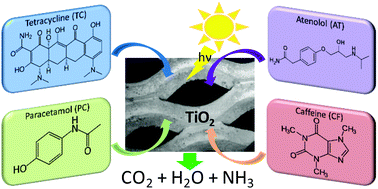Emerging pollutant mixture mineralization by TiO2 photocatalysts. The role of the water medium†
Abstract
Pharmaceutics and personal care products (PPCPs) are raising growing concern due to their widespread usage and resistance to conventional remediation techniques. Several of them raise significant health and environmental concerns, especially when present in complex mixtures. Due to their chemical resistance, Advanced Oxidation Processes (AOPs) are needed for their complete removal from surface and wastewaters. In the present work, photocatalysis by titanium dioxide (TiO2) under UV and simulated solar irradiation was adopted to degrade tetracycline hydrochloride, paracetamol, caffeine and atenolol, both as single pollutants and in mixtures. All molecules showed high removal and mineralization degrees. Moreover, no interference effects decreased the efficiency of the processes in the case of pollutant mixtures, achieving 60% of mineralization after 6 h. An immobilized TiO2 system was also developed by depositing titania on titanium meshes. A 50% mineralization degree of the pollutant mixture was obtained after 6 h, revealing a suitable efficiency for field applications. Eventually, the impact of the matrix composition on the photocatalytic efficiency was investigated by studying the reaction both in simulated drinking water and in commercial bottled mineral water. The scavenger role played by HCO3− species appears to be dominant in inhibiting the mineralization.

- This article is part of the themed collection: Solar chemistry & photocatalysis – environmental applications


 Please wait while we load your content...
Please wait while we load your content...